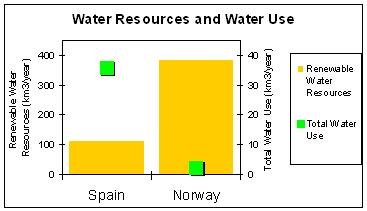|
|
 |
|
|
|
 |
| |
|
|
 |
Food & Climate
Read more |
Why is drought an important issue in Mediterranean countries?
Mediterranean climates, with hot dry summers and wet winters, are amongst the most variable in the world. Recurrent drought problems often affect entire countries for several years in a row and can result in serious social problems.
|
|
|
|
|
 |
|
In general, rainfall is concentrated between October and March (southern countries like Algeria or Morocco) or April (northern countries like Portugal or Italy). Average temperatures in these areas decrease with increasing altitude and latitude. The weather is characterised by large inter-annual variability. Summer rainfall (June, July and August) is well below 100 mm in all regions, except in the north of Spain and Portugal.
|
 |
 |
|
1. Climate diagrams for Lérida and Almería. From: CEDEX.
|
|
 |
In each season, water supply must be matched with water demands. During drought periods, the lack of available water leads to conflicts among water users and disputes between countries.
These figures show the distribution of rainfall, temperature and solar radiation for two different regions in Spain.
Lerida is a region in the northeast of the country and is characterised by large temperature differences between summer and winter. Rainfall is fairly evenly distributed throughout the year with slightly higher amounts in spring and autumn than in the summer and winter.
The region of Almeria is around 500 km south of Lerida. Temperature differences are less extreme throughout the year but rainfall is very low, particularly in the summer when it is close to zero.
|
Agriculture
Over 50% of the land area in the Mediterranean region is used for agriculture and agriculture is the main user of water. Agriculture consumes over 80% of the total water demand in Mediterranean African countries and around 60% of the total water demand in northern Mediterranean European countries. As a result, drought has a huge impact on agricultural activities.
|
Drought affects food production and food security. Mediterranean cultures have been farming for several millennia and farmers are well aware of the negative impacts of drought. Irrigated agriculture in the region has greatly expanded to ensure food production targets and these targets have increased the problems experienced during drought periods. Connections between current and predicted future water availability in the region and food production are receiving increasing attention.
These figures show the different distribution of water use for two European countries, one in the North of Europe and the other one in the Mediterranean basin. Countries like Spain use most of their water for agricultural purposes while industry uses most of the water in Norway. Note that the total amount of water used in Spain is around 18 times more than that used in Norway.
|
 |
 |
 |
|
2. Water use in the different sectors in Spain and Norway. Adapted from AQUASTAT, FAO.
|
|
 |
 |
|
3. Water use in Norway and Spain
Adapted from AQUASTAT, FAO
|
|
 |
This figure clearly shows that Spain has access to just a quarter of the total water available in Norway. It also clearly shows that Spain requires much larger amounts of water than Norway. As water availability decreases further, this imbalance between supply and demand will get worse.
|
|
Social and policy issues
In the Mediterranean, climate is an essential component of the natural capital and an important element of sustainable development. Water is not only a major socio-economic element but an essential cultural element as well. As a result, the policy debates related to water have been, and will continue to be, vigorous.
Effective measures to cope with water scarcity are known, but are difficult to implement due to the variety of stakeholders and inadequate means to negotiate new policies. Any efforts made to improve communication among the scientific and decision-making communities will have great benefits for the future of water management in the region.
The social impacts of water scarcity in the Mediterranean are increasing and will likely be worsen. Cultural impediments to limiting water use are an additional source of concern.
|
About this page:
Author: Marta Moneo and Dr. Ana Iglesias - Universidad Politécnica de Madrid, España
1. scientific reviewer: Alex de Sherbinin - CIESIN, Columbia University, USA
2. scientific reviewer: Lily Parshall - Goddard Institute for Space Studies, Columbia University, USA
educational reviewer: Emilio Sternfeld - Colegio Virgen de Mirasierra - España
last published: 2004-05-12
|
|
 |
|







